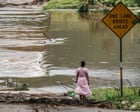
Recent extreme weather patterns have highlighted the importance of remaining prepared and resilient in the face of natural disasters. This past week, both Texas and the northern Indian state of Himachal Pradesh experienced devastating flash floods, causing significant damage and loss. While the immediate aftermath is challenging, communities have begun assessing the impact with determined resolve to rebuild and support those affected.
In Texas, an area colloquially known as “Flash Flood Alley” due to its vulnerability, massive thunderstorms were intensified by moisture from the remnants of Tropical Storm Barry. Kerr County, particularly, bore the brunt, receiving over 300mm of rain in a few short hours. As waters surged rapidly, they left a trail of destruction in their wake. The flooding was especially acute at a summer camp, where 28 young girls had gone missing amidst the torrents.
Sadly, as of Sunday evening, authorities confirmed the tragic loss of at least 89 lives across the region. Officials have diligently worked to recover 75 bodies, comprising 48 adults and 27 children. These figures underscore the storm’s intensity and speed, which caught many off guard despite precautionary measures. In the aftermath, rescue teams are actively engaged in search operations, bringing hope for additional recoveries and reunions.
Simultaneously, across the globe in India, the mountainous terrain of Himachal Pradesh faced its own severe weather challenges. Unusually heavy rainfall led to 23 flash floods and 16 landslides over the weekend, washing away hundreds of homes, roads, and critical infrastructure like bridges and electricity pylons. Adding to the complexity were 19 cloudbursts—sudden, intense rainfalls—compounding floodwaters and landslide risks.
Communities across Himachal Pradesh now find themselves grappling with the aftermath. Clearing debris and restoring essential services are top priorities as they work tirelessly to locate dozens reported missing. State government officials have initiated comprehensive relief efforts, coordinating local and national resources to address immediate needs while planning for long-term recovery and mitigation strategies.
Despite the challenges, both Texas and Himachal Pradesh demonstrate resilient spirits and community cohesiveness in the face of adversity. Stories of neighbors helping neighbors, volunteers joining hands with authorities to provide emergency aid, and international expressions of solidarity offer a soothing balm of hope and humanity amid these trials.
These recent events are reminders of the dynamic and sometimes unpredictable nature of our planet’s weather systems. As climate patterns continue evolving, so must our readiness and infrastructure. The efforts to build more resilient communities, better equipped to withstand and adapt to such events, continue to gain momentum. Encounters with extreme weather push the scientific, governmental, and public sectors into collaborative action, exploring innovative approaches and technologies to enhance forecasting, response, and infrastructure resilience.
In moving forward, a deeper understanding of how to balance our natural coexistence with proactive preparation remains pivotal. This includes investing in technology, community education, and sustainable practices designed to mitigate the impact of future natural events. Indeed, while forces of nature wield considerable power, the spirit of human resolve to rebuild and adapt embodies a quiet strength that perseveres and prevails. It is this strength that carries the hope for more resilient and prepared communities worldwide.
For now, as each affected community embarks on its healing journey, the focus remains on recovery, support, and the path towards a safer future. With compassion, collaboration, and mindful attention to the lessons learned, they are poised not only to rebuild but to emerge more resilient than before, equipped to meet whatever nature has in store.
Source: {link}
